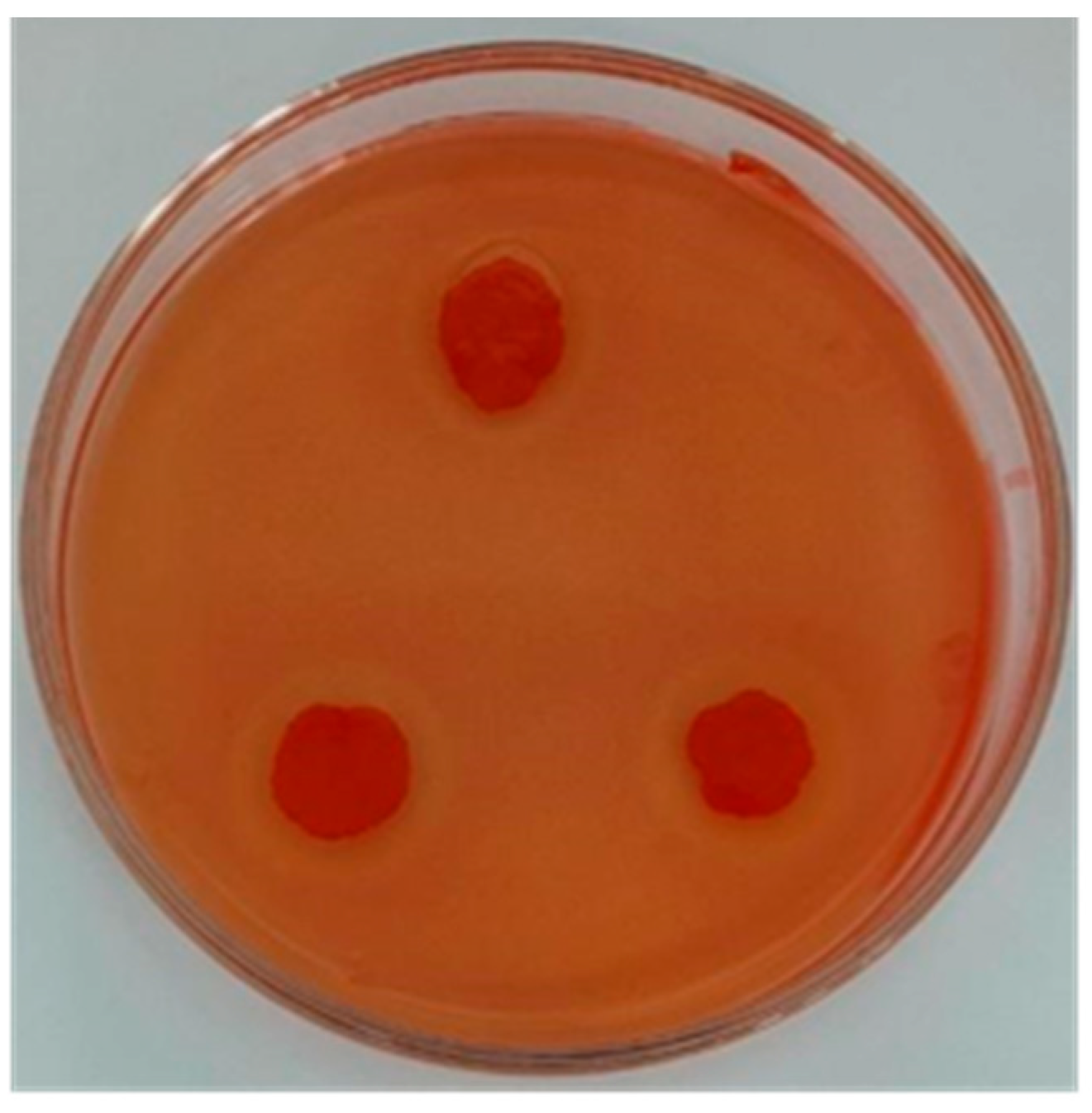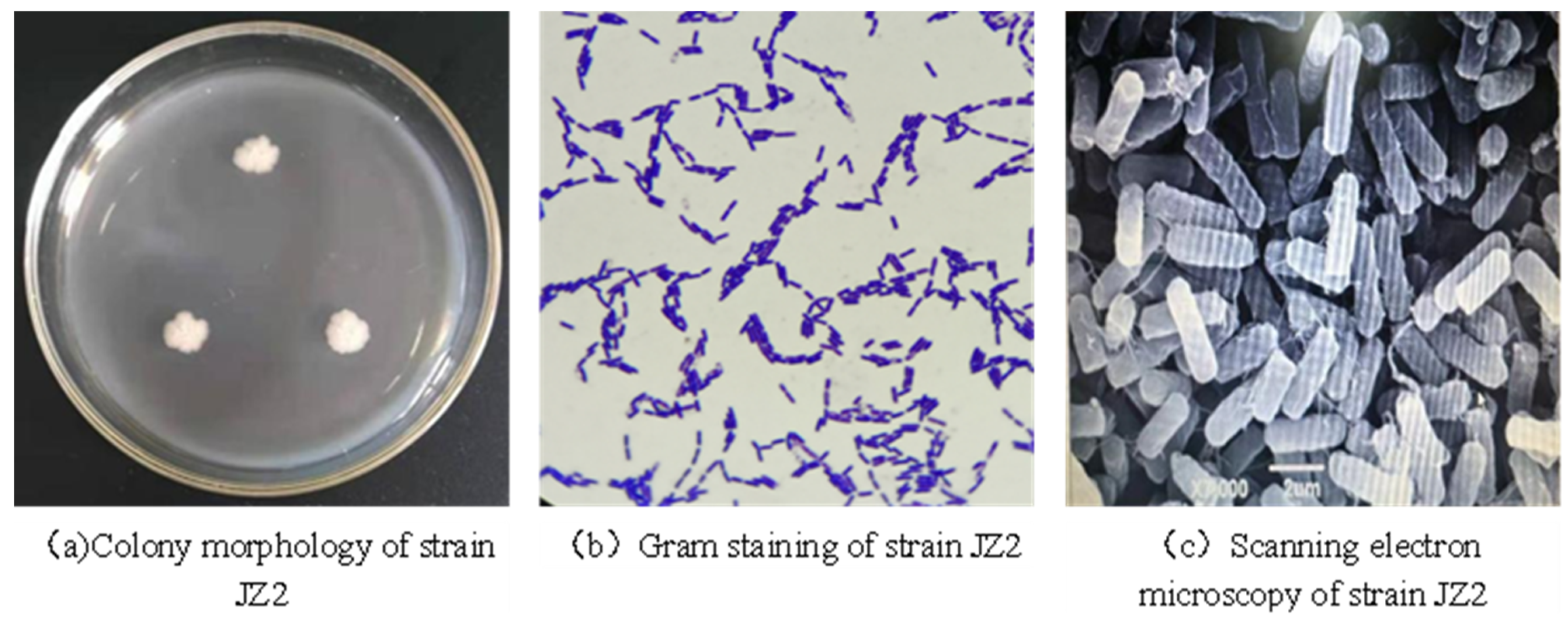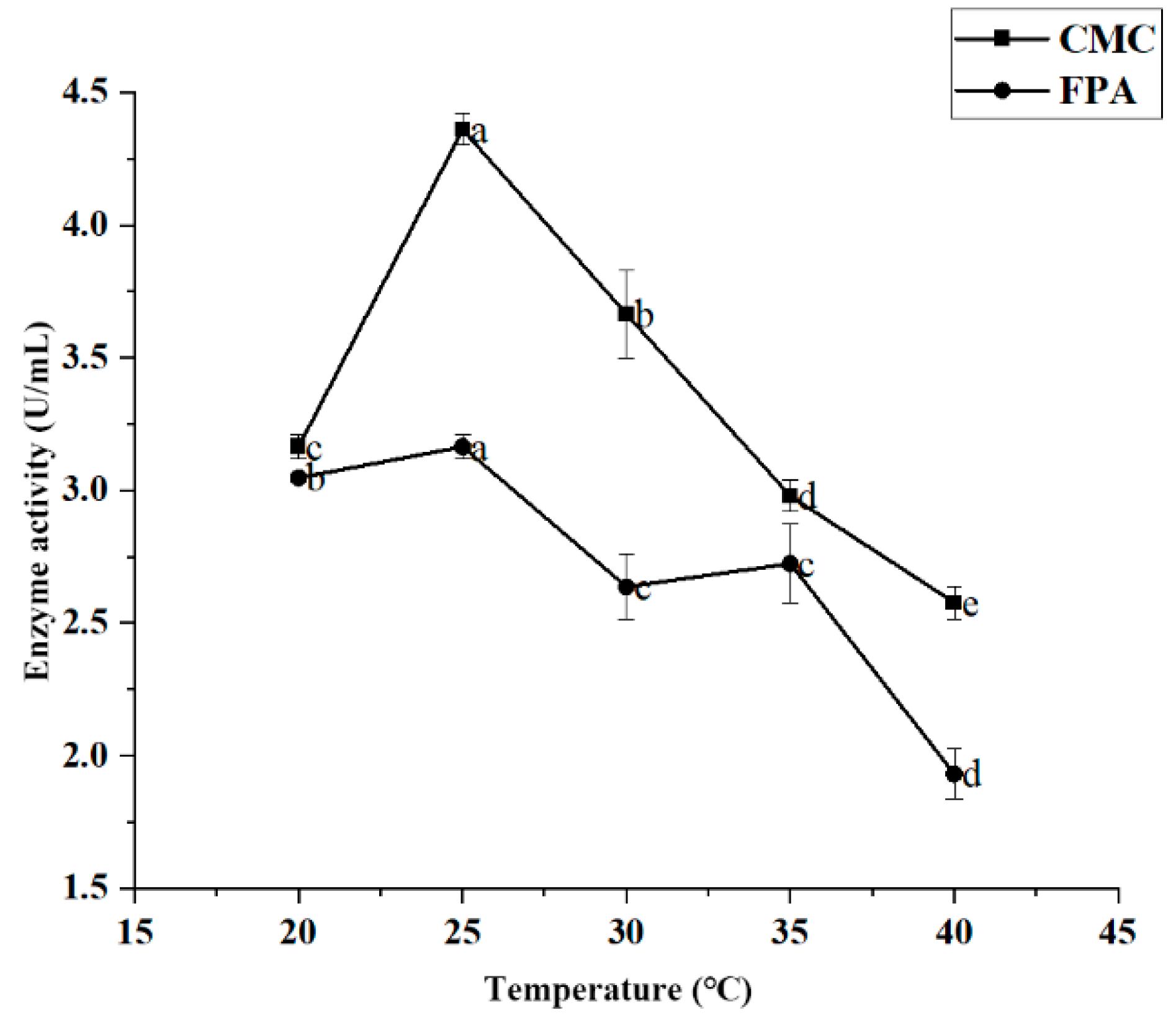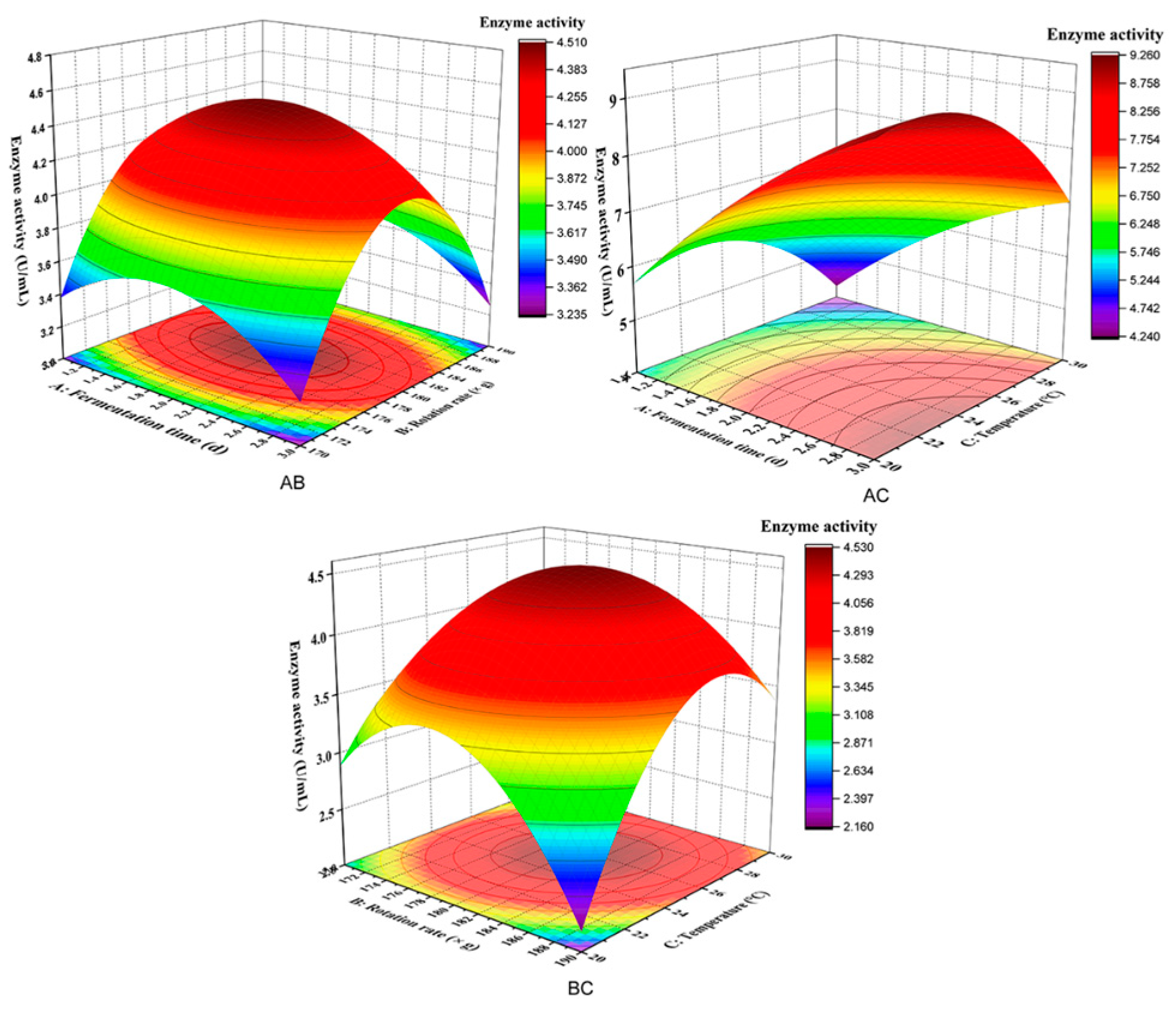Screening, Identification, and Optimization of Enzyme-Producing Conditions for Cellulose-Degrading Bacteria in Distillery Lees
Abstract
:1. Introduction
2. Materials and Methods
2.1. Materials
2.2. Test Method
2.2.1. Initial Screening of Cellulose-Degrading Bacteria
2.2.2. Rescreening of Cellulose-Degrading Bacteria
2.2.3. Strains Identification
Physiological and Biochemical Identification
Molecular Identification
2.2.4. Optimization of Enzyme Production Conditions for Strain Fermentation
Single Factor Test
Response Surface Test
2.3. Statistical Analysis
3. Results and Analysis
3.1. Isolation and Screening of Cellulose-Degrading Bacteria
3.2. Identification of Strains
3.2.1. Morphological Identification
3.2.2. Physiological and Biochemical Identification
3.2.3. Molecular Identification
3.3. Optimization of Enzyme Production Conditions for Strain Fermentation
3.3.1. Single Factor Results
Effect of Fermentation Time on Enzyme Activity
Effect of Rotation Rate on Enzyme Activity
Effect of Incubation Temperature on Enzyme Activity
3.3.2. Response Surface Optimization Test Results
3.3.3. Validation Test
4. Conclusions
5. Prospects
- (1)
- Further exploration of the fermentation conditions for strain JZ2 and the Saccharomyces cerevisiae complex to improve the strains’ synergistic effect;
- (2)
- Modification of strain JZ2 by mutagenesis or molecular means to improve its degradation ability and enzyme production conditions;
- (3)
- Develop a multi-strain complex, enhance the enzyme system through the synergistic effect of different strains, and improve the treatment of distillery lees.
Author Contributions
Funding
Acknowledgments
Conflicts of Interest
References
- Liu, Y.F.; Ren, M.J.; Lei, H.X.; Li, H.L.; Zheng, X.G. Research progress on feed comprehensive utilization of distiller’s grains. Agric. Technol. Svcs. 2023, 40, 88–90. [Google Scholar]
- Ma, Y.C.; Hou, Y.X.; Huang, M.Q.; Ye, H.; Zheng, Y.; Wu, J.H.; Sun, B.G. Current status and prospects of research and utilization of Baijiu industry by-products as biomass resources. Food Ferment. Indus. 2022, 48, 292–306. [Google Scholar]
- Torres, M.A.; Valdez, A.L.; Angelicola, M.V.; Raimondo, E.E.; Pajot, H.F.; Nieto-Peñalver, C.G. Vinasse as a substrate for inoculant culture and soil fertigation: Advancing the circular and green economy. Sci. Total Environ. 2023, 887, 164014. [Google Scholar] [CrossRef]
- Yang, J.; Zhang, Z.; Ding, X.; Chen, X.; Yin, C.; Yang, E.; Sun, D.; Wang, W.; Guo, F. Multiple responses optimization of antioxidative components extracted from distiller’s grains using response surface methodology and identify their chemical compositions. J. Food Process Preserv. 2021, 45, e15885. [Google Scholar] [CrossRef]
- Nie, Y.Z. Reflection on the current situation and innovative application of comprehensive utilization of distiller’s grains. Lt. Indus. Tech. 2021, 37, 11–12. [Google Scholar]
- Chen, Y.; Xiong, K.N.; Chi, Y.K.; Xiao, H.; Chen, H. The development and utilization of Baijiu distiller’s grains as feed and its enlightenment to rocky desertification areas in Guizhou. China Feed. 2021, 31, 105–111. [Google Scholar]
- Fan, E.-D.; Jiang, M.-Y.; Feng, M.-X.; Chen, Y.-F.; Xiao, D.-G.; Guo, X.-W. Optimization of Fermentation Conditions for Production of Feed Containing Functional Components from Distiller’s Grains by Mixed Bacteria Fermentation. Biotechnol. Bull. 2021, 37, 91. [Google Scholar]
- Ao, T.; Ran, Y.; Chen, Y.; Li, R.; Luo, Y.; Liu, X.; Li, D. Effect of viscosity on process stability and microbial community composition during anaerobic mesophilic digestion of Maotai-flavored distiller’s grains. Bioresour. Technol. 2020, 297, 122460. [Google Scholar] [CrossRef]
- Abiodun, A.S.; Oladimeji, F.N.; Peter, O.M.; Raphael, B.B. Environmental management and uses of vinasse-review. Asian J. Curr. Res. 2016, 1, 46–60. [Google Scholar]
- Fan, E.D.; You, X.L.; Zhang, J.; Cheng, P.Y.; Hu, F.; Xu, S. Study on the Comprehensive Utilization of Baijiu Brewing Waste Distiller’s Grains. Brewing Tech. 2022, 42, 99–104. [Google Scholar]
- Taoka, Y.; Nagano, N.; Kai, H.; Hayashi, M. Degradation of distillery lees (Shochu kasu) by cellulase-producing thraustochytrids. J. Oleo Sci. 2017, 66, 31–40. [Google Scholar] [CrossRef] [Green Version]
- Lan, X.; Chen, X.; Zhang, J.; Liang, Z.; Gu, Y. Investigation on degradation and reuse of cellulose in distiller’s grains. Anim. Husb. Feed. Sci. Inn. Mong. 2018, 39, 21–22. [Google Scholar]
- Deng, S.G. Screening of Fungi for Degradation of Crude Fiber from Baijiu Distiller’s Grains and Preliminary Study on Degradation Technology. Master’s Thesis, Jiangxi Agricultural University, Nanchang, China, 2018. [Google Scholar]
- Zhang, Y. Screening of Efficient Cellulose Degrading Composite Bacterial Strains and Their Degradation Functions. Master’s Thesis, Tianjin University, Tianjin, China, 2019. [Google Scholar]
- Asgher, M.; Wahab, A.; Bilal, M.; Iqbal, H.M. Delignification of lignocellulose biomasses by alginate–chitosan immobilized laccase produced from Trametes versicolor IBL-04. Waste Biomass Valorization 2018, 9, 2071–2079. [Google Scholar] [CrossRef]
- Khosravi, F.; Khaleghi, M.; Naghavi, H. Screening and identification of cellulose-degrading bacteria from soil and leaves at Kerman province, Iran. Arch. Microbiol. 2021, 204, 88. [Google Scholar] [CrossRef]
- Li, J.; Li, M.Y.; Wang, J.L.; Zhang, T.; Zhou, Q. Research progress in microbial degradation of cellulose. Food Indus. Tech. 2022, 43, 396–403. [Google Scholar]
- Lynd, L.R.; Weimer, P.J.; Van Zyl, W.H.; Pretorius, I.S. Microbial cellulose utilization: Fundamentals and biotechnology. Microbiol. Mol. Biol. Rev. 2002, 66, 506–577. [Google Scholar] [CrossRef] [PubMed] [Green Version]
- Seidl, V.; Gamauf, C.; Druzhinina, I.S.; Seiboth, B.; Hartl, L.; Kubicek, C.P. The Hypocrea jecorina (Trichoderma reesei) hypercellulolytic mutant RUT C30 lacks a 85 kb (29 gene-encoding) region of the wild-type genome. BMC Genom. 2008, 9, 327. [Google Scholar] [CrossRef] [Green Version]
- Liu, L.; Zhang, S.; Yang, X.; Ju, M.T. Cellulose isolation from corn stalk treated by alkaline biochars in solvent systems. BioResources 2018, 13, 691–703. [Google Scholar] [CrossRef]
- Ning, L.J. Screening, Fermentation Conditions Optimization, and Application of Cellulose Degrading Bacteria from Distiller’s Grains Unpublished. Master’s Thesis, Hebei University, Baoding, China, 2022. [Google Scholar]
- Yu, M.X.; Zhu, Y.; Cheng, D.; Lu, J. Screening and identification of cellulose degrading bacteria in distiller’s grains sludge. J. Fuyang Norm. Univ. 2021, 38, 58–62. [Google Scholar]
- Behera, S.S.; Ray, R.C. Solid state fermentation for production of microbial cellulases: Recent advances and improvement strategies. Int. J. Biol. Macromol. 2016, 86, 656–669. [Google Scholar] [CrossRef]
- Song, L.L.; Wen, G.; Huo, S.H.; Hu, X.L.; Yang, X.; Zhang, Z.P. Isolation and screening of cellulase producing bacteria from Baijiu distiller’s grains and study on their enzymatic properties. Food Ferment. Indus. 2020, 46, 43–49. [Google Scholar]
- Yaoling, W.; Xiaoli, X.; Xianglian, Z.; Xibin, L.; Heyu, W.; Li, W. Isolation and Compost Application of High-Activity Cellulose-degrading Strains from Distiller’s Grains. J. Henan Agric. Sci. 2022, 51, 79. [Google Scholar]
- Hussain, A.A.; Abdel-Salam, M.S.; Abo-Ghalia, H.H.; Hegazy, W.K.; Hafez, S.S. Optimization and molecular identification of novel cellulose degrading bacteria isolated from Egyptian environment. J. Genet. Eng. Biotechnol. 2017, 15, 77–85. [Google Scholar] [CrossRef] [PubMed]
- Zuo, Y.; Qin, S.R.; He, S.J.; Xu, J.; Yang, J.F.; Huang, X.Q. Screening and identification of high cellulase producing strains from distiller’s grains. Feed Res. 2021, 44, 82–87. [Google Scholar]
- Zhou, L.; Chen, L.; Lu, H.M.; Mo, L.Q.; Xu, S. Isolation and identification of high-temperature bacteria from sauce flavored distiller’s grains in Maotai area. China Brewing. 2016, 35, 61–65. [Google Scholar]
- Abdelhamid, S.A.; El-Shatoury, E.H.; Asker, M.S.; Abd-El-Aal, S.K.; Mohamed, S.S. Hydrolysis of Cellulose Rich Agricultural Waste Using Two Potent Local Bacterial Isolates. Proc. Natl. Acad. Sci. India Sect. B Biol. Sci. 2023, 93, 225–234. [Google Scholar] [CrossRef]
- Li, H.; Zhou, S.; Johnson, T.; Vercruysse, K.; Lizhi, O.; Ranganathan, P.; Phambu, N.; Ropelewski, A.J.; Thannhauser, T.W. Genome Structure of Bacillus cereus tsu1 and Genes Involved in Cellulose Degradation and Poly-3-Hydroxybutyrate Synthesis. Int. J. Polym. Sci. 2017, 2017, 6192924. [Google Scholar] [CrossRef] [Green Version]
- Ariffin, H.; Abdullah, N.; Umi Kalsom, M.; Shirai, Y.; Hassan, M. Production and characterization of cellulase by Bacillus pumilus EB3. Int. J. Eng. Technol. 2006, 3, 47–53. [Google Scholar]
- Jo, K.-I.; Lee, Y.-J.; Kim, B.-K.; Lee, B.-H.; Chung, C.-H.; Nam, S.-W.; Kim, S.-K.; Lee, J.-W. Pilot-scale production of carboxymethylcellulase from rice hull by Bacillus amyloliquefaciens DL-3. Biotechnol. Bioprocess Eng. 2008, 13, 182–188. [Google Scholar] [CrossRef]
- Lejeune, R.; Baron, G. Effect of agitation on growth and enzyme production of Trichoderma reesei in batch fermentation. Appl. Microbiol. Biotechnol. 1995, 43, 249–258. [Google Scholar] [CrossRef]
- Li, H.; Dou, M.; Wang, X.; Guo, N.; Kou, P.; Jiao, J.; Fu, Y. Optimization of cellulase production by a novel endophytic fungus Penicillium oxalicum R4 isolated from Taxus cuspidata. Sustainability 2021, 13, 6006. [Google Scholar] [CrossRef]
- Dhakal, R.; Bajpai, V.K.; Baek, K.-H. Production of GABA (γ-aminobutyric acid) by microorganisms: A review. Braz. J. Microbiol. 2012, 43, 1230–1241. [Google Scholar] [CrossRef] [PubMed] [Green Version]
- Wang, W.; Nema, S.; Teagarden, D. Protein aggregation—Pathways and influencing factors. Int. J. Pharm. 2010, 390, 89–99. [Google Scholar] [CrossRef] [PubMed]
- Dong, D.; Che, Z.M.; Guan, T.W. Screening of cellulase producing strains from Baijiu distiller’s grains and detection of their enzyme activity. China Brewing. 2015, 34, 44–48. [Google Scholar]







| Factor | The Level of | ||
|---|---|---|---|
| −1 | 0 | 1 | |
| Time (d) | 1 | 2 | 3 |
| Rotation rate (× g) | 170 | 180 | 190 |
| Temperature (°C) | 20 | 25 | 30 |
| The Name of the Strain | Diameter of Transparent Ring, D/(mm) | Diameter of the Colony, d/(mm) | Ratio (D/d) |
|---|---|---|---|
| JZ1 | 4.00 ± 0.35 | 4.00 ± 0.23 | 1.00 ± 0.16 b |
| JZ2 | 16.00 ± 0.47 | 8.00 ± 0.51 | 2.00 ± 0.08 a |
| JZ3 | 15.00 ± 0.55 | 8.00 ± 0.38 | 1.88 ± 0.12 a |
| JZ4 | 20.00 ± 0.42 | 18.00 ± 0.44 | 1.11 ± 0.17 b |
| JZ5 | 16.00 ± 0.62 | 12.00 ± 0.47 | 1.33 ± 0.13 b |
| The Name of the Strain | Endoglucanase Activity (U/mL) | Exoglucanase Activity (U/mL) | β-glucosidase Activity (U/mL) |
|---|---|---|---|
| JZ1 | 0.531 ± 0.023 c | 2.450 ± 0.023 c | 0.274 ± 0.011 c |
| JZ2 | 1.874 ± 0.041 a | 4.341 ± 0.057 a | 0.739 ± 0.025 a |
| JZ3 | 1.550 ± 0.025 b | 3.312 ± 0.022 b | 0.568 ± 0.045 b |
| JZ4 | 0.443 ± 0.044 c | 2.538 ± 0.104 c | 0.201 ± 0.014 cd |
| JZ5 | 0.511 ± 0.072 c | 2.088 ± 0.040 d | 0.152 ± 0.029 d |
| Appraisal Indicators | Appraisal Results |
|---|---|
| Glucose | + |
| Starch hydrolysis | + |
| Mannitol | − |
| Simon’s citrate | − |
| Power medium | + |
| Nitrate broth | − |
| V-P | + |
| Gelatin medium | + |
| Lysozyme broth | + |
| 3% catalase | + |
| Serial Number | Fermentation Time (d) | Rotation Rate (× g) | Temperature (°C) | Enzyme Activity (U/mL) |
|---|---|---|---|---|
| 1 | 3.00 | 180.00 | 20.00 | 2.960 |
| 2 | 1.00 | 180.00 | 30.00 | 3.910 |
| 3 | 1.00 | 190.00 | 25.00 | 3.204 |
| 4 | 3.00 | 170.00 | 25.00 | 3.420 |
| 5 | 2.00 | 170.00 | 20.00 | 2.881 |
| 6 | 2.00 | 180.00 | 25.00 | 4.654 |
| 7 | 2.00 | 190.00 | 30.00 | 3.361 |
| 8 | 3.00 | 180.00 | 30.00 | 3.400 |
| 9 | 2.00 | 180.00 | 25.00 | 4.625 |
| 10 | 2.00 | 170.00 | 30.00 | 2.303 |
| 11 | 2.00 | 190.00 | 20.00 | 2.470 |
| 12 | 2.00 | 180.00 | 25.00 | 4.292 |
| 13 | 2.00 | 180.00 | 25.00 | 4.331 |
| 14 | 2.00 | 180.00 | 25.00 | 4.625 |
| 15 | 1.00 | 170.00 | 25.00 | 3.508 |
| 16 | 1.00 | 180.00 | 20.00 | 2.823 |
| 17 | 3.00 | 190.00 | 25.00 | 3.126 |
| Source | Sum of Squares | Degrees of Freedom | Mean Square | F-Value | Probability > F | Significant |
|---|---|---|---|---|---|---|
| Model | 8.72 | 9 | 0.9689 | 13.30 | 0.0013 | Significant |
| A—Time | 0.0363 | 1 | 0.0363 | 0.4985 | 0.5030 | |
| B—Rotation rate | 0.0003 | 1 | 0.0003 | 0.0041 | 0.9506 | |
| C—Temperature | 0.4232 | 1 | 0.4232 | 5.81 | 0.0468 | Significant |
| AB | 0.0000 | 1 | 0.0000 | 0.0003 | 0.9857 | |
| AC | 0.1047 | 1 | 0.1047 | 1.44 | 0.2697 | |
| BC | 0.5395 | 1 | 0.5395 | 7.41 | 0.0297 | Significant |
| A2 | 0.4745 | 1 | 0.4745 | 6.51 | 0.0380 | Significant |
| B2 | 3.08 | 1 | 3.08 | 42.27 | 0.0003 | Significant |
| C2 | 3.38 | 1 | 3.38 | 46.44 | 0.0002 | Significant |
| Residuals | 0.5100 | 7 | 0.0729 | |||
| Misfit | 0.3833 | 3 | 0.1278 | 4.04 | 0.1056 | Not significant |
| Pure error | 0.1266 | 4 | 0.0317 | |||
| Sum | 9.23 | 16 |
Disclaimer/Publisher’s Note: The statements, opinions and data contained in all publications are solely those of the individual author(s) and contributor(s) and not of MDPI and/or the editor(s). MDPI and/or the editor(s) disclaim responsibility for any injury to people or property resulting from any ideas, methods, instructions or products referred to in the content. |
© 2023 by the authors. Licensee MDPI, Basel, Switzerland. This article is an open access article distributed under the terms and conditions of the Creative Commons Attribution (CC BY) license (https://creativecommons.org/licenses/by/4.0/).
Share and Cite
Luo, A.-G.; Wang, Y.-Y.; Xue, S.-S.; Zhao, J.; Hao, J.-W.; Shi, S.-L.; Hu, B.-F. Screening, Identification, and Optimization of Enzyme-Producing Conditions for Cellulose-Degrading Bacteria in Distillery Lees. Appl. Sci. 2023, 13, 7693. https://doi.org/10.3390/app13137693
Luo A-G, Wang Y-Y, Xue S-S, Zhao J, Hao J-W, Shi S-L, Hu B-F. Screening, Identification, and Optimization of Enzyme-Producing Conditions for Cellulose-Degrading Bacteria in Distillery Lees. Applied Sciences. 2023; 13(13):7693. https://doi.org/10.3390/app13137693
Chicago/Turabian StyleLuo, Ai-Guo, Yuan-Yuan Wang, Sha-Sha Xue, Jia Zhao, Jian-Wei Hao, Sheng-Li Shi, and Bian-Fang Hu. 2023. "Screening, Identification, and Optimization of Enzyme-Producing Conditions for Cellulose-Degrading Bacteria in Distillery Lees" Applied Sciences 13, no. 13: 7693. https://doi.org/10.3390/app13137693
APA StyleLuo, A.-G., Wang, Y.-Y., Xue, S.-S., Zhao, J., Hao, J.-W., Shi, S.-L., & Hu, B.-F. (2023). Screening, Identification, and Optimization of Enzyme-Producing Conditions for Cellulose-Degrading Bacteria in Distillery Lees. Applied Sciences, 13(13), 7693. https://doi.org/10.3390/app13137693





